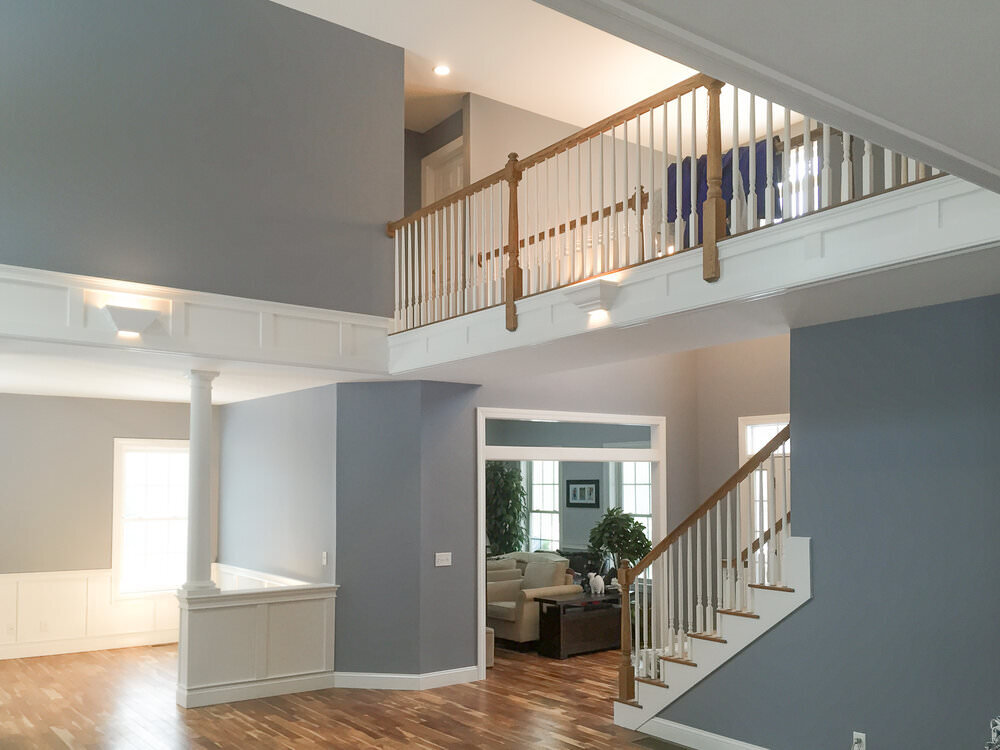How to Paint Open Concept and Two-Story Spaces
In most homes, the task of choosing paint colors for different rooms is fairly straightforward and can even be enjoyable. You can choose a different color for each room without the end result causing too much interruption to the flow of the rooms in your home.
However, there are certain styles of rooms that make the paint selection process a little more difficult. Open-concept and two-story rooms, in particular, can make your paint color choices more involved and complex, requiring you to consider additional factors and the question, “where does one wall end and the next wall begin?” If you’re planning on having your open concept or two-story space painted, have a look at our helpful tips to help you choose paint colors for these open areas of your home.
Two-story Rooms
Two-story rooms can be difficult to paint because the loftier ceiling height creates very long, tall wall space. Two-story rooms generally allow more light in, hence both your color and your sheen decision are affected. Consider an instance where you have a one-story family room and a two-story family room. Picture the space as though it was the same room in your house but with two different ceiling heights. Painting them both a deep, rich blue would tend to make the one-story room feel cozy, maybe more closed in. The two-story space, on the other hand, with its soaring ceiling, wouldn’t necessarily appear cozy or small because of the added light and space.
Once you have a color palette in mind, make sure that the two-story space doesn’t have adjacent walls that must be painted the same color, unless you’re prepared to and want to make the adjacent walls that color. Adjacent walls with no break, such as a ceiling, trim, or door, would require you to use one continuous color.
If you don’t prefer to paint the adjoining, adjacent walls a color you’ve chosen for the first of two nearby walls, you’ll need to reconsider your initial color choice, either by making the shade lighter or choosing another color altogether.
A great way to handle this is to choose a neutral color that you’ll use in all of your “transition” spaces. Paint your two-story area and all adjacent hallways and spaces in this same neutral color to keep your home’s separate but connected areas cohesive. This will make all spaces looking as though they belong together, not one area looking lovely, while the other area suffers with the wrong color choice.
Light beiges are a good choice for this, especially since many two-story spaces have lots of windows and natural light. Let that natural light shine by keeping the space light and airy. If you want color in your space still, you can then look to your furnishings and fixtures, or if you’re more bold, you can have your ceiling painted to add color in a way that doesn’t overwhelm the space.
Open-Concept Rooms
Open-concept rooms have a similar problem to two-story rooms, but with the added frustration of trying to make one room multi-functional. In an open-concept space, you often have the kitchen, a dining area, living room, and maybe an office all in one space, which can look messy and unintentional without the right color design. Still, you want something to help keep the room looking cohesive.
One of the easiest ways to tie an entire open-concept room together is through the trim. Having the same trim thickness and color will help unify your space and make it look intentional. Next, you will want to choose the paint colors for your walls. You can make the easier choice and paint all the connecting walls in your open-concept space the same color. Choose the best color for you with the help of your designer or painting contractor, taking into consideration your tastes, existing furniture and furnishings, amount of light, and size of the room.
The more difficult choice of choosing paint color for your open-concept space involves choosing different colors in the one space. Luckily, color is used more creatively than in previous years as we see different color cabinets or different countertop materials and colors (for example, an island made with white marble and the rest of the countertops made of quartz in a gray pattern) in one kitchen. Back in the day, color wasn’t mixed quite like it is today.
Using different paint colors on different walls is a great way to differentiate each of your spaces, but if it is not done with care it can make your room look chaotic. Keeping your wall colors in the same color family is a great way to keep it looking professional and subtle. Once you’ve decided on your colors, color placement can be very important in open-concept rooms. Utilize the angles in your room to help naturally divide the space. If you need a break on an open wall, using molding to your advantage to cover up a transition area.
Overall, you want to make sure that each color is being used to its full advantage, with darker colors used as accents and lighter colors taking up the most space in the room. Finally, you will want to finish with a neutral ceiling to help keep the space from being too overwhelming.
We know that it can be challenging to choose a paint color you’ll love for years to come for today’s more open spaces. We’ll work with your designer, decorator, contractor, or directly with you to make this and all other painting and updating choices for your home, including trim work, cabinet repainting and refinishing, and more. Contact Big Dog Painting for your in-person or virtual estimate.


